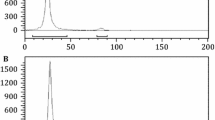Summary
For equilibrium binding isotherms of radioreceptor assays, the affinity spectrum is defined as a plot of the number of binding sites against their corresponding dissociation constants. A numerical procedure for direct calculation of affinity spectra from untransformed binding data is presented and illustrated with experimental values. The advantage of the new method in comparison to non-linear regression analysis is the fact that no starting values and mathematical models have to be supplied and that statistical assessment of the results is straightforward from a detailed graphical display of a likelihood function. Affinity spectra thus show directly all information formerly obtained by means of both graphical plots and regression analysis.
Similar content being viewed by others
Abbreviations
- DAGO:
-
DAla2, MePhe4, Gly(ol)5-enkephalin
- GppNHp:
-
guanyl-5′yl-imidodiphosphat
- ICYP:
-
(±)-3-[125Iodo]cyanopindolol
References
Boeynaems JM, Dumont JE (1980) Outlines of receptor theory. Elsevier, Amsterdam
Bylund DB, Snyder SH (1976) Beta-adrenergic receptor binding in membrane preparations from mammalian brain. Mol Pharmacol 12:586–680
Cheng YC, Prusoff WH (1973) Relationship between the inhibition constant K i and the concentration of inhibitor which caused 50% inhibition (I50) of an enzymatic reaction. Biochem Pharmacol 22:3099–3108
DeLean A, Hancock AA, Lefkowitz RJ (1982) Validation and statistical analysis of a computer modelling method for quantitative analysis of radioligand binding data for mixtures of pharmacological receptor subtypes. Mol Pharmacol 21:5–16
Engel G (1981) Subclasses of beta-adrenoceptors, a quantitative estimation of beta-1 and beta-2 adrenoceptors in guinea pig and human lung. Postgrad Med J (Suppl) 57:77–83
Engel G, Hoyer D, Berthold R, Wagner H (1981) (±)[125Iodo] cyanopindolol, a new ligand for β-adrenoceptors: identification and quantitation of subclasses of β-adrenoceptors in guinea pig. Naunyn-Schmiedeberg's Arch Pharmacol 317:277–285
Feldman HA (1972) Mathematical theory of complex binding-systems at equilibrium. Anal Biochem 48:317–338
Maurer R, Engel G (1982) Simultaneous differentiation of three opiate receptor subpopulations. J Receptor Res (in press)
Molinoff BP, Wolfe BB, Weiland GA (1981) Quantitative analysis of drug receptor interactions. II. Determination of the properties of receptor subtypes. Life Sci 29:427–443
Scatchard G (1949) The attraction of proteins for small molecules and ions. Ann NY Acad Sci USA 51:660–672
Snedecor GW, Cochran WG (1973) Statistical methods 6th edn. The Iowa State Univ. Press, Iowa/USA
Stiefel E (1963) Einführung in die numerische Mathematik. B. G. Teubner, Stuttgart, p 28
Thakur AK, Munson PJ, Hunston DL, Rodbard D (1980) Characterisation of ligand-binding systems by continuous affinity distributions of arbitrary shape. Anal Biochem 103:240–254
Author information
Authors and Affiliations
Rights and permissions
About this article
Cite this article
Tobler, H.J., Engel, G. Affinity spectra: A novel way for the evaluation of equilibrium binding experiments. Naunyn-Schmiedeberg's Arch. Pharmacol. 322, 183–192 (1983). https://doi.org/10.1007/BF00500763
Received:
Accepted:
Issue Date:
DOI: https://doi.org/10.1007/BF00500763




